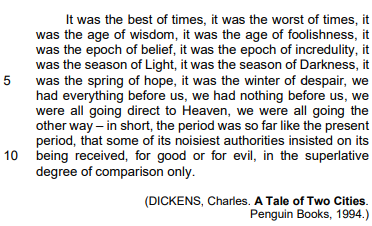Questões Militares Comentadas por alunos sobre interpretação de texto | reading comprehension em inglês
Foram encontradas 1.449 questões
Resolva questões gratuitamente!
Junte-se a mais de 4 milhões de concurseiros!
Directions: Read Text V and answer the question accordingly.

(SUMMER, Bernard; GILBERT, Gillian; HOOK, Peter; MORRIS,
Stephen. Lyrics to Love Vigilantes, performed by New Order,
Low Life CD, track 1, Universal Music Publishing Group, 1986.
Taken from https://lyricfind.com)
I. The war referred by the speaker is over.
II. The speaker had been conscripted to engage in combat.
III. Some parts of speech were left out of the phrase in line 4.
IV. The use of the auxiliary verb in line 13 is substandard.
V. The noun in line 17 is a false cognate.
The only correct statements are
Directions: Read Text IV and answer the question accordingly.

Vocabulary:
1. Bid (bade, bidden): to tell somebody to do something.
Directions: Read Text II and answer question 03 accordingly.
TEXT II

The extract above